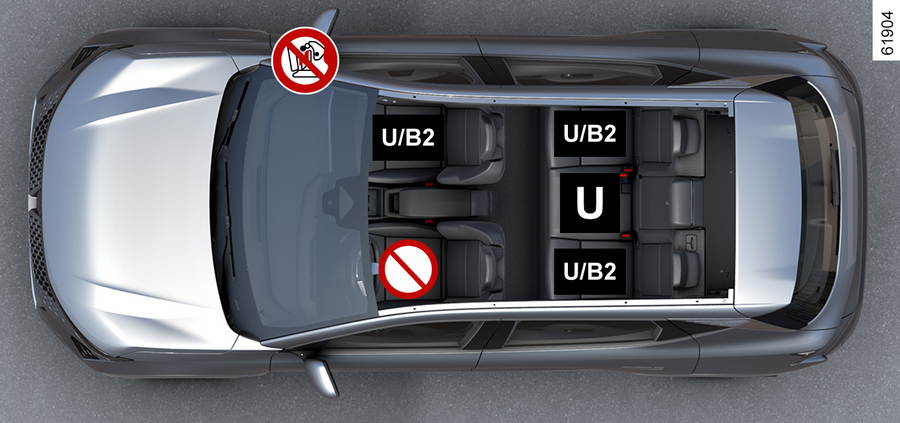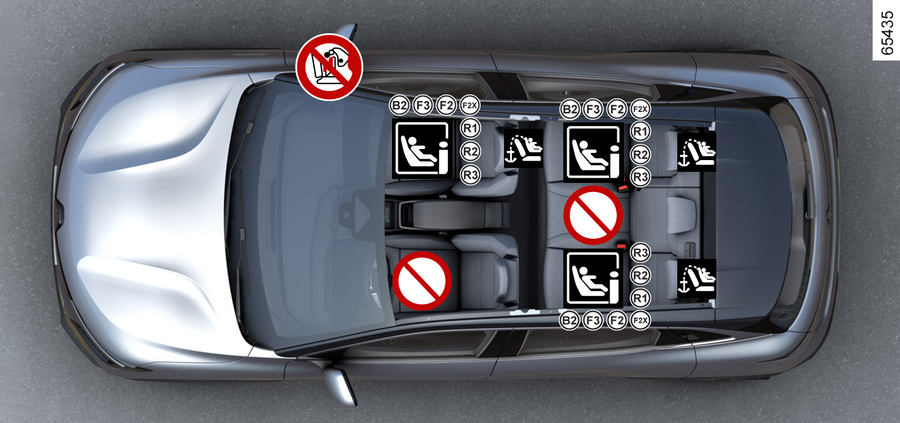Child seats
Child seats
Attachment by seat belt
Fitting diagram

WARNING
RISK OF DEATH OR SERIOUS INJURY: after fitting a rear-facing child seat on the front passenger seat, make sure that
the airbag has been deactivated PASSENGER DETECTION SYSTEMCHILD SAFETY.
- Check the status of the airbag before fitting a child seat or allowing a passenger to use the seat.
- Seat not suitable for fitting child seats.
Child seat attached using the belt
- Seat equipped for attaching a "universal" approved seat using a seatbelt.
- Seat enabling a child seat with "B2" approval to be attached by seat belt.
WARNING
Using a child safety system which is not approved for this vehicle will not properly
protect the baby or child. They risk serious or even fatal injury.
WARNING
Check that your child is always strapped in and that the belt or safety harness used
is correctly set and adjusted.
If necessary, adjust the seat position accordingly.
WARNING
Do not fit a child seat when the large seat back is in the folded position.
Installation table
The table below summarises the information already shown on the diagram on the previous
page, to ensure the regulations in force are respected.
Type of child seat | Weight of the child | Front passenger seat | Rear side seats | Rear centre seat | |
With airbag deactivated | With airbag activated | ||||
Carrycot fitted across the vehicle Group 0 | < 10 kg | X | X | U (2) | U (2) |
Rear-facing shell seat Groups 0 or 0 + | < 10 kg and < 13 kg | U (1) (5) | X | U (3) | U (3) (6) |
Shell seat/rear-facing seat Groups 0+ and 1 | < to 13 kg and 9 to 18 kg | U (1) (5) | X | U (3) | U (3) (6) |
Forward-facing seat Group 1 | 9 to 18 kg | U (5) | X | U (4) | U (4) (6) |
Booster seat Groups 2 and 3 | 15 to 25 kg and 22 to 36 kg | U / B2 (5) | X | U / B2 (4) | U (4) |
WARNING
(1) RISK OF DEATH OR SERIOUS INJURY: after fitting a rear-facing child seat on the front passenger seat, make sure that
the airbag has been deactivated PASSENGER DETECTION SYSTEMCHILD SAFETY.
X = Seat not suitable for fitting child seats of this type.
U = Seat enabling a child seat with "Universal" approval to be attached by seat belt:
check that it can be fitted.
B2 = Boosters in groups 2 and 3 (15 to 25 kg and 22 to 36 kg).
(2) A carrycot can be installed across the vehicle and will take up at least two seats.
Position the child with his or her feet nearest the door.
(3) If necessary, position the vehicle seat as far back as possible. In order to install
a rear-facing child seat, move the front seat as far forward as possible, then move
the front seat back as far as it will go, without allowing it to come into contact
with the child seat.
(4) In all situations, remove the rear headrest of the seat on which the child seat is
positioned. This must be done before fitting the child seat. Move the seat in front
of the child forwards, move the seatback forward to avoid contact between the seat
and the child's legs.
(5) Raise the seat to the maximum and position it as far back as possible, tilting the
seatback slightly (approximately 25°).
WARNING
(6) RISK OF DEATH OR SERIOUS INJURY: a child seat with a floor support must never be fitted.
Attachment with the ISOFIX system
Fitting diagram

Tip
For the front passenger seat, the use of a child seat with a floor support is recommended
to avoid triggering the seat belt warning signal.
WARNING
Using a child safety system which is not approved for this vehicle will not properly
protect the baby or child. They risk serious or even fatal injury.
WARNING
Fitting a seat ISOFIX in the rear-left seat means the middle seat cannot be used. The central seat belt
will no longer be either accessible or useable.
WARNING
RISK OF DEATH OR SERIOUS INJURY:
after fitting a rear facing child seat on the front passenger seat, check that the
airbag has been deactivated PASSENGER DETECTION SYSTEMCHILD SAFETY.
- Seat which does not allow a child seat to be fitted.
Child seat attached using theISOFIX system
- Seat equipped for attaching a ISOFIX or i-Size child seat.
WARNING
Check that your child is always strapped in and that the belt or safety harness used
is correctly set and adjusted.
If necessary, adjust the seat position accordingly.
WARNING
Do not fit a child seat when the large seat back is in the folded position.
WARNING
Fit the child seat in a rear seat wherever possible.
To install an ISOFIX seat in this seat, unbuckle the seat belt by hand before engaging the bolts.
Installation table
The table below summarises the information already shown on the diagram on the previous
page, to ensure the regulations in force are respected.
Type of child seat | Weight of the child | Size of seat [fixture] | Front passenger seat | Rear side seats | Rear centre seat | |
With airbagISOFIX deactivated | With airbagISOFIX activated | |||||
Carrycot fitted across the vehicle Group 0 | < 10 kg | L1 [F] L2 [G] | X | X | IL (2) | X |
Rear-facing shell seat Groups 0 or 0 + | < 13 kg | R1 [E] | IL (1) (3) | X | IL (4) | X |
Rear-facing seat Groups 0+ and 1 | < to 13 kg and 9 to 18 kg | R3 [C] R2 [D] | IL (1) (3) | X | IL (4) | X |
Forward-facing seat Group 1 | 9 to 18 kg | F3 [A] F2 [B] F2X [B1] | IUF-IL (3) | X | IUF-IL (4) (5) | X |
Booster seat Groups 2 and 3 | 15 to 25 kg and 22 to 36 kg | B2 | IUF-IL (3) | X | IUF-IL (4) (5) | X |
Seati-Size | I - U (1) (3) | X | I - U (4) (5) | X | ||
X = Seat not suitable for fitting child seats.
U = Seat enabling a child seat with "Universal" approval to be attached by seat belt:
check that it can be fitted.
IUF-IL = Seat enabling a child seat with "Universal/Semi-universal or vehicle-specific"
approval to be attached by ISOFIX (on equipped vehicles): check that it can be fitted.
WARNING
(1) RISK OF DEATH OR SERIOUS INJURY: after fitting a rear-facing child seat in the front passenger seat, make sure that
the front passenger airbag has been deactivated PASSENGER DETECTION SYSTEMCHILD SAFETY.
(2) A carrycot can be installed across the vehicle and will take up at least two seats.
Position the child with his or her feet nearest the door.
(3) Raise the seat to the maximum and position it as far back as possible, tilting the
seatback slightly (approximately 25°).
(4) If necessary, position the vehicle seat as far back as possible. In order to install
a rear-facing child seat, move the front seat as far forward as possible, then move
the front seat back as far as it will go, without allowing it to come into contact
with the child seat.
(5) In all situations, remove the rear headrest of the seat on which the child seat is
positioned. This must be done before fitting the child seat. Move the seat in front
of the child forwards, move the seatback forward to avoid contact between the seat
and the child's legs.
The size of the ISOFIX child seat is indicated by a letter:
- F3,F2,F2X[A, B, B1]: for forward-facing seats in group 1 (9 to 18 kg);
- B2: boosters in groups 2 and 3 (15 to 25 kg and 22 to 36 kg);
- R3, R2[C, D]: rear-facing seats or shell seats in group 0+ (less than 13 kg) or group 1 (9 to 18 kg);
- R1[E]: rear-facing shell seats in group 0 (less than 10 kg) or 0+ (less than 13 kg);
- L1,L2[F,G]: carrycots in group 0 (under 10 kg).